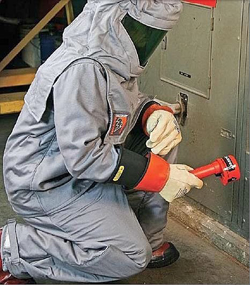Arc Flash Personal Protective Equipment Explained

Arc Flash Personal Protective Equipment
Electricians and all qualified employees working with live or de-energized electrical equipment must wear arc flash personal protective equipment as protection against electrical hazards. Electrical hazards, such as arc flashes, can seriously injure or fatally wound employees. All non-qualified employees require protection from electrical hazards by the use of barricades, attendants, enclosures, safety signs, and insulation.
The National Electrical Code (NFPA 70E: electrical safety standard in the workplace) use Hazard Risk Categories to indicate the severity of possible danger on electrical equipment. For example, electrical equipment categorized with the Hazard Risk Category of Dangerous (greater than 4 [40 cal/cm2]) cannot be maintained, operated, or serviced while it’s turned on (live) without the appropriate permits and approvals.
Electricians and other workers that are qualified to work on electrical equipment must be protected from arc-flash hazards and shock hazards. Arc Flash Personal Protective Equipment details for electrical workers against arc flash hazards, for example, include PPE (eye protection, fire-resistant clothing, face shield, among others) barricades and distance. Shock hazard protection is similar: PPE (insulated tools, rubber gloves), insulation, barricades, and distance.
Arc Flash Personal Protective Equipment Procedures
The following are some of the arc flash safety precautions and procedures must be adhered at all times:
- Qualified workers with the appropriate approvals are forbidden from letting unqualified employees to enter the arc flash protection area while electrical equipment is in operation or live parts are exposed.
- Unqualified employees must be notified by qualified workers of any arc flash hazard.
- Qualified workers are required to wear the appropriate Arc Flash Personal Protective Equipment within the arc flash protection area.
- If incident energy passes 40 cal/cm2, then equipment operation is forbidden.
- Authorized workers should know if an arc flash analysis is performed and should wear the appropriate PPE identified on the warning sticker.
- Qualified workers should at least wear Arc Flash Personal Protective Equipment while working on electrical equipment that has been labeled a non-arc flash hazard.
- Long-sleeve shirts are required to be worn by authorized workers to ensure neck and wrists are buttoned. Any exposed area on the body must be protected by an outer layer of Arc Flash Personal Protective Equipment as much as possible.
- Read More Here: Arc Flash and Electrical Safety
- Read More Here: Electrical Safety Training
- Read More Here: Electricity
For more information, see:
On-site training
Interested in cost effective, professional on-site electrical smart grid training?
We can present an On-site Training Course to your electrical engineering and maintenance staff, on your premises, tailored to your specific equipment and requirements. Click on the link below to request a FREE quotation.
Live Online Electrical Training Schedule
November 2025
- Power Transformer Maintenance Training
- NFPA 70b Training - Electrical Maintenance
- Emergency Generators & Standby Power Systems
- 2024 CE Code - Changes and Fundamentals
- 2024 CE Code - Combined Course: Changes/Fundamentals and Calculations
- Arc Flash Training - CSA Z462 Electrical Safety
- Lightning Protection Systems Training For Utility, Industrial, Commercial & Institutional power systems
- CE Code Calculations: Practical Applications and Advanced Techniques
- Substation Relay Protection Training
- Energy Storage Systems Course
- Combined NFPA 70e LV Arc Flash And HV Electrical Safety
- NFPA 70e Training
Arc Flash Group Training

We can present this Course to your electrical engineering and maintenance staff, on your premises, tailored to your specific equipment and requirements. We are ready to help design this program for you. Click on the link below to request a FREE quotation.
